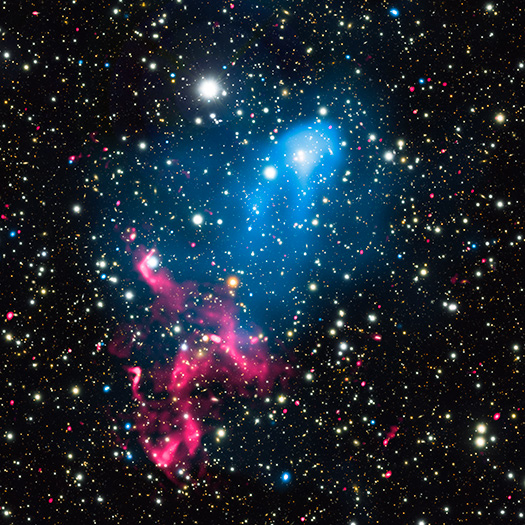For Release: January 5, 2017
CXC
Astronomers have discovered a cosmic one-two punch unlike any ever seen before. Two of the most powerful phenomena in the Universe, a supermassive black hole, and the collision of giant galaxy clusters, have combined to create a stupendous cosmic particle accelerator.
By combining data from NASA's Chandra X-ray Observatory, the Giant Metrewave Radio Telescope (GMRT) in India, the NSF's Karl G. Jansky Very Large Array, and other telescopes, researchers have found out what happens when matter ejected by a giant black hole is swept up in the merger of two enormous galaxy clusters.
"We have seen each of these spectacular phenomena separately in many places," said Reinout van Weeren of the Harvard-Smithsonian Center for Astrophysics (CfA) in Cambridge, Mass., who led the study that appears in the inaugural issue of the journal Nature Astronomy. "This is the first time, however, that we seen them clearly linked together in the same system."
This cosmic double whammy is found in a pair of colliding galaxy clusters called Abell 3411 and Abell 3412 located about two billion light years from Earth. The two clusters are both very massive, each weighing about a quadrillion — or a million billion — times the mass of the Sun.
The comet-shaped appearance of the X-rays detected by Chandra is produced by hot gas from one cluster plowing through the hot gas of the other cluster. Optical data from the Keck Observatory and Japan's Subaru telescope, both on Mauna Kea, Hawaii, detected the galaxies in each cluster.
First, at least one spinning, supermassive black hole in one of the galaxy clusters produced a rotating, tightly-wound magnetic funnel. The powerful electromagnetic fields associated with this structure have accelerated some of the inflowing gas away from the vicinity of the black hole in the form of an energetic, high-speed jet.
Then, these accelerated particles in the jet were accelerated again when they encountered colossal shock waves — cosmic versions of sonic booms generated by supersonic aircraft — produced by the collision of the massive gas clouds associated with the galaxy clusters.
"It's almost like launching a rocket into low-Earth orbit and then getting shot out of the Solar System by a second rocket blast," said co-author Felipe Andrade-Santos, also of the CfA. "These particles are among the most energetic particles observed in the Universe, thanks to the double injection of energy."
This discovery solves a long-standing mystery in galaxy cluster research about the origin of beautiful swirls of radio emission stretching for millions of light years, detected in Abell 3411 and Abell 3412 with the GMRT.
The team determined that as the shock waves travel across the cluster for hundreds of millions of years, the doubly accelerated particles produce giant swirls of radio emission.
"This result shows that a remarkable combination of powerful events generate these particle acceleration factories, which are the largest and most powerful in the Universe," said co-author William Dawson of Lawrence Livermore National Lab in Livermore, Calif. "It is a bit poetic that it took a combination of the world's biggest observatories to understand this."
These results were presented at the 229th meeting of the American Astronomical Society meeting in Grapevine, TX. NASA's Marshall Space Flight Center in Huntsville, Alabama, manages the Chandra program for NASA's Science Mission Directorate in Washington. The Smithsonian Astrophysical Observatory in Cambridge, Massachusetts, controls Chandra's science and flight operations.
A labeled image, a podcast, and a video about the findings are available at:http://chandra.si.edu
For more Chandra images, multimedia and related materials, visit:
http://www.nasa.gov/chandra
Media contacts:
Megan Watzke
Chandra X-ray Center, Cambridge, Mass.
617-496-7998
mwatzke@cfa.harvard.edu




Visitor Comments (4)
Outstanding.
Posted by L.Lntz on Friday, 11.24.17 @ 19:22pm
Hey everyone.
Absolutely fabulous photographs. Because of your excellent work getting the photographs and explaining the phenomenon in terms easy enough that my 10yr old godson was able to read and comprehend almost everything... Now he wants to be an astronaut.
The only thing I wish you could have included a photo of just the 2 Galaxies.
Posted by Katherine on Sunday, 01.22.17 @ 19:46pm
I was wondering who's the author of this article, not the published article on the Journal of Nature, but the author who wrote this summary?
Posted by Khalad on Sunday, 01.15.17 @ 11:03am
Is that the real colors or just to show contrast?
Posted by Paul on Friday, 01.6.17 @ 20:38pm